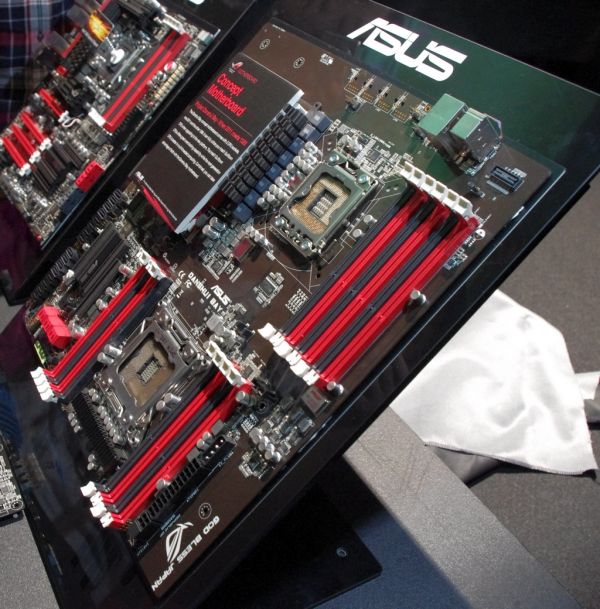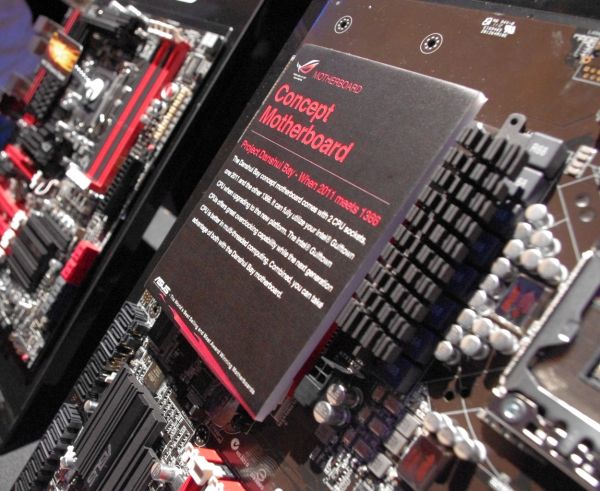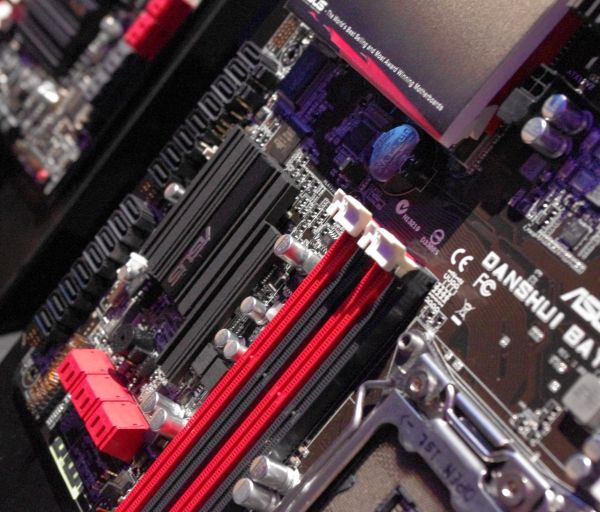Computex 2011: Danshui Bay Concept Motherboard
by Ian Cutress on June 3, 2011 7:53 PM EST- Posted in
- Computex 2011
- Motherboards
- M1000
- Asus
- Trade Shows
ASUS have been coming to Computex to sensationalize and dazzle the press with concepts for years, and this year is no different, regardless of whether something is technically feasible or not. Last year, we saw the ASUS Immensity motherboard concept that was never put into production – an X58 featuring a 5450-type integrated GPU and a Lucid Hydra chip to combine any discrete GPU combination on board. This year takes a turn for the surreal.
Introducing the Danshui Bay concept:
Simply put, ASUS are wanting to combine two chipsets on one motherboard – the X58 socket 1366, and the X79 socket 2011. If we completely disregard the technical challenges this faces, it provides the interesting idea of something that might be possible in the future: You want to upgrade your machine to the latest chipset and processor. Rather than throw your old processor away or sell it on, you could buy a motherboard that lets you harness the power of the old processor and a new processor together, in some form of chimerism.
As for the technical challenges in producing such a product, I could reel off a whole list. For a start, chipsets are not designed to talk to each other. Processors need dual QPI links to talk to each other of the same model – how that would work with different socket processors with different caches and core counts is also a mystery, as with 1366 you would need an appropriate Xeon. With two chipsets, you’ll have to have a different set of memory for each processor, and possibly getting a mismatch there based on dual/tri/quad channel memory. Each processor requires its power and a set of PCIe each – unless you disregard the PCIe of one of the chipsets but then you would have to have at least the processor of the other socket in order to run a discrete GPU. The same goes with SATA ports, I/O connectors, USB headers, and so on.
Obviously, this board presented is a mockup – merely bits and pieces put together. It’s showing sixteen SATA 3 Gbps and six SATA 6 Gbps for a start, as well as no significant power delivery and an obscene form factor. ASUS only want to know that if there was a demand for such a product, despite the technical limitations.



















52 Comments
View All Comments
ggathagan - Saturday, June 4, 2011 - link
The dual technology concept isn't new, but like previous examples of coupling two different technologies, there are always trade-offs in performance or features.Usually the trade-offs are enough to prevent most people from buying the boards.
Remember the Apollo Pro133A that VIA produced in the early 2000's with support for Slot1/Socket 370?
Tyan's Trinity 400 was quite popular, but couldn't match the BX-based boards for performance or overclocking.
They were also taking advantage of Intel's disastorous decision to embrace RAMBUS.
And it's not been that long ago that ASRock was making its mark with other VIA and ULi chipsets that supported PCIe/AGP or DDR1/DDR2.
In both cases, however, they were slower than their Intel or AMD counterparts.
With VIA/Centaur focusing on their processors and ULi being absorbed by NVIDIA, there's no longer anyone even interested in producing alternative chipsets for either AMD or Intel, let alone being legally able to do so.
liveonc - Saturday, June 4, 2011 - link
There were Full Tower Chasis that could fit an ATX + mini ITX. What about an ARM + x86 mobo that are independandt of each other, but fit on the same ATX mobo?marraco - Sunday, June 5, 2011 - link
This would work better with AMD, since AMD maintains better socket compatibility between generations.I love the concept. I don't want to throw away my i7 920 and 6Gb of ram. If I upgrade, it would be to a 12/16 cores, which will not be much faster than the i7 on single threaded software. So upgrade only makes sense when there is available a lot of massively parallel software, able to take advantage of many cores. Then, 4 old cores will not be something to look down.
PubFiction - Monday, June 6, 2011 - link
Concept cars can really be out there, but at least most concept cars actually function and are possible.So they glue a whole bunch of shit together that will never happen and it gets the press they hoped for.
This is kinda stupid really, to even be reporting on it. They should have a functional item even if it is buggy in order for it to be news. I mean I can go into the garage and solder a bunch of junk together that does not work will you report on it?
This would actually make sense if we were talking about an ARM CPU to quickboot and a real CPU for power applications and productivity. Both have access to all your data. And you have something like a bigger better asus transformer or better yet Acer iconia W500/A500 combo.
zhongkki - Monday, June 6, 2011 - link
very good web,believe you will love it.
FREE SHIPPING,accept paypal
discount including evisu jeans,watches shirts,bags,hat and the decorations
trust me!
Quickly snapping up right
compcons - Monday, June 6, 2011 - link
Although the usefulness is debatable, the idea of using multiple chipsets, with discreet channels to multiple sockets isn't necessarily new. Although the implementation is a bit different, Tyan did this quite successfully with the Thunder K8WE. Each CPU had its own chipset, with separate buses and independent RAM. Effectively, the board segregated each CPU with it's own graphics slot and RAM. Obviously, this is different, but not completely out of the realm of possibility.http://www.tyan.com/product_board_spec.aspx?pid=15...
Let’s not forget the Gigabyte EP45 board that could run DDR2 or DD3 or the old AGP/PCIe boards from ECS. Again, not sure about the utility of such things.
EH
Arbie - Monday, June 6, 2011 - link
I agree that this is a publicity joke not even worth reporting. Why did AT waste my time?If Asus mobo designers have so much free time, I wish they would fix the fan speed selection ranges in the Rampage Formula BIOS. The existing ranges are ridiculous (down to 16 degC!) with steps so large as to make them useless. Three years and they haven't fixed this.
FWIW, "irregardless" is simply poor English, and no amount of using it will improve things. The OED gives a first reference as a dialect dictionary in 1912.
JoJoman88 - Tuesday, June 7, 2011 - link
Put two SB-E sockets on the motherboard and then we wil talk about it.ruzveh - Tuesday, June 7, 2011 - link
I think its a good idea overall. But need some tweaking here. To put it as it can become a single mdb for both Intel and AMD, isnt it? U got the option to use any cpu or chipset u like on this board without upgrading it or getting confuse which cpu and chipset to go for. Well Done Asus.. Thumbs upWhy throw a motherboard to change over system or upgrade them? Save wastage save enviornment.. Afterall more than 90% of the components are similar on every mdb.
goodsyntax - Tuesday, June 7, 2011 - link
You can restructure the old monolithic vs. packaged arguments that Intel and AMD had when they first rolled out dual core and quad core chips.Technically, it may not be as high in terms of raw performance as a truly unified board, but you could use some of the interconnect technologies in cloud and distributed computing (Fibre-channel, inifiband, messaging, queuing, etc.) to connect both board segments and make them work together. The software/firmware effort of course would be tremendous, but you could pull it off and make two discrete PCs/servers appear and behave as one. Why you would invest the R&D cost to do so is another question.
Personally, I think resources would be better utilized in designing a more modular, component based system where the "motherboard" is really just high speed lanes for storage, memory, compute and graphic subsystems. We've already taken some steps in the high-end server area with daughterboards and add-in cards, but to design a motherboard from the ground up as just I/O interconnects for the various subsystems just makes more sense. You want to upgrade your CPU from a single socket 2011 to dual socket, drop in a new compute board. Need more memory - add another daughterboard.
Imagine a time when the motherboard is just thousands of I/O lanes that you simply drop modules into. That would certainly take the pain out of upgrades. You only upgrade what you want to upgrade instead of having to worry the entire system. Certainly big changes, such as memory standards (DDR2 to DDR3) would require two new add-in boards, but at least it's modular and reusing/repurposing components is far more sensible than throwing away an entire system because one part of it is obsolete.